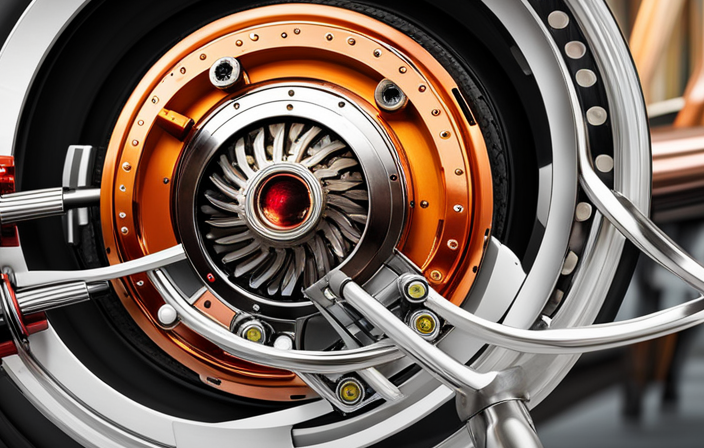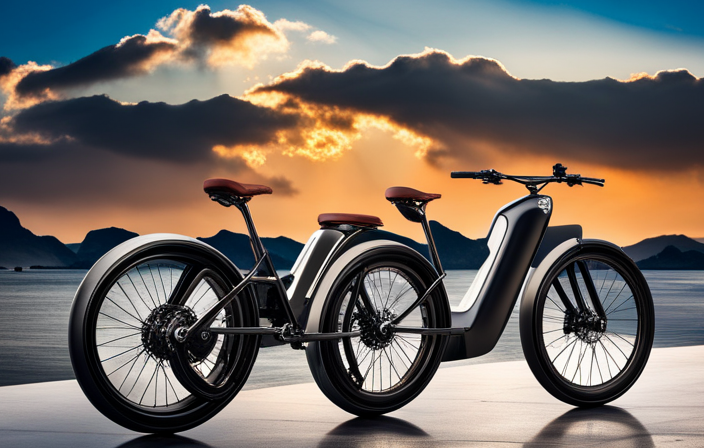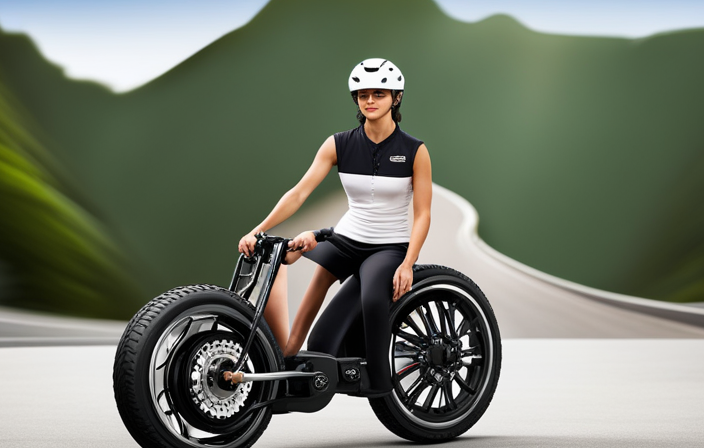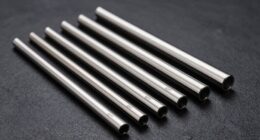As an avid cyclist, I’ve always been fascinated by the inner workings of electric bike hub motors. It’s incredible how these compact devices can generate the power needed to propel a bike forward effortlessly.
In this article, we’ll delve into the mechanics behind electric bike hub motors, exploring their components, power generation, and various types. We’ll also discuss the pros and cons of using these motors, as well as the exciting potential of regenerative braking.
So, buckle up and get ready to dive into the fascinating world of electric bike hub motors!
Key Takeaways
- Regenerative braking with electric bike hub motors increases overall efficiency of the bike.
- Electric bike hub motors provide a smoother and more controlled braking experience.
- Electric bike hub motors recover and store energy that would otherwise be wasted.
- Electric bike hub motors offer user-friendly controls for easy adjustment of speed and power.
What is an Electric Bike Hub Motor?
An electric bike hub motor is a motor that is built into the hub of the bike’s wheel, allowing for a more efficient and powerful ride.
There are two main types of electric bike hub motors: the front hub motor and the rear hub motor.
The front hub motor is located on the front wheel, providing a balanced and stable ride.
On the other hand, the rear hub motor is situated on the rear wheel, delivering more power and torque for uphill climbs and higher speeds.
The advantages of electric bike hub motors are numerous. They provide a smooth and quiet ride, as well as improved handling and control. Additionally, they offer a seamless integration with the bike’s design, making them less noticeable.
Transitioning into the subsequent section about the components of an electric bike hub motor, let’s take a closer look at how these motors work.
The Components of an Electric Bike Hub Motor
To understand the components of your electric bike hub motor, you’ll need to familiarize yourself with its inner workings. Here are the three main components that make up an electric bike hub motor:
-
Stator: This stationary part of the motor contains the core and winding coils. The stator is responsible for generating a magnetic field when an electric current passes through the coils.
-
Rotor: The rotor is the moving part of the motor and is connected to the bike’s wheel. It consists of permanent magnets that interact with the magnetic field generated by the stator, causing the rotor to spin.
-
Controller: The controller is the brain of the electric bike hub motor. It receives signals from the throttle or pedal sensor and regulates the amount of power supplied to the motor. It also monitors and protects the motor from overheating or overloading.
Understanding these components is crucial for electric bike hub motor maintenance and troubleshooting common issues. By knowing how each component functions, you’ll be better equipped to diagnose and fix any problems that may arise.
Now let’s delve into how an electric bike hub motor generates power.
How Does an Electric Bike Hub Motor Generate Power?
When it comes to understanding how an electric bike hub motor generates power, two key points to consider are electromagnetic induction and commutation.
Electromagnetic induction refers to the process by which a changing magnetic field induces an electric current in a conductor, such as the coils of the hub motor.
Commutation, on the other hand, involves the switching of the current direction in the motor’s coils to maintain continuous rotation.
These two concepts are crucial in explaining the power generation mechanism of an electric bike hub motor.
Electromagnetic Induction
The electric bike hub motor works by using electromagnetic induction to generate power. When a magnetic field is created within the motor, it induces an electric current in a nearby conductor, according to Faraday’s law of electromagnetic induction. This current is known as an eddy current.
The eddy current, in turn, generates a magnetic field that interacts with the original magnetic field, causing the motor’s rotor to rotate. This rotation creates mechanical energy, which is then converted into electrical energy to power the bike.
It’s fascinating how the principles of electromagnetic induction, discovered by Faraday, allow us to harness the power of electricity in such an efficient and sustainable way.
Now, let’s move on to discuss the next important aspect of the electric bike hub motor: commutation.
Commutation
Now, you may be wondering how commutation plays a role in the operation of the electric bike hub motor.
Commutation is a crucial process in a brushless motor, which is commonly used in electric bike hub motors. It involves the timely switching of current to the motor’s coils, ensuring continuous rotation.
This switching is controlled by a torque sensor, which detects the rider’s pedaling force and adjusts the motor’s output accordingly. The torque sensor sends signals to the motor controller, which then determines the appropriate amount of power to be delivered to the motor.
By accurately regulating the commutation process, the motor can provide smooth and efficient operation, giving the rider a seamless and enjoyable riding experience.
Moving forward, let’s delve into the different types of electric bike hub motors.
Types of Electric Bike Hub Motors
Choose from different types of electric bike hub motors based on your specific needs and preferences.
When it comes to electric bike hub motors, there are several options available, each catering to different wheel sizes.
For smaller wheel sizes, such as 20 inches or less, a geared hub motor is a popular choice. It provides excellent torque and acceleration, making it ideal for urban commuting or off-road adventures.
On the other hand, for larger wheel sizes, like 26 inches or more, a direct drive hub motor is a great option. It offers a smoother and quieter ride, making it perfect for long-distance trips or leisurely rides.
Additionally, hub motors have certain advantages over mid drive motors. They are more compact, require less maintenance, and provide a more balanced weight distribution.
Now, let’s explore the pros and cons of electric bike hub motors.
Pros and Cons of Electric Bike Hub Motors
One of the advantages of electric bike hub motors is that they offer a smoother and quieter ride compared to mid drive motors. Increased stability due to the weight distribution being centralized in the hub. Improved efficiency as the motor directly drives the wheel, reducing power loss. Simplified maintenance since the motor is housed within the wheel, making it easily accessible. Easy installation as hub motors can be retrofitted onto existing bikes.
However, there are some disadvantages to consider. Limited torque, which can make climbing steep hills challenging. Increased weight due to the motor being located in the wheel, affecting maneuverability. Reduced handling and responsiveness compared to mid drive motors. Limited compatibility with certain bike frames or wheel sizes.
Despite these drawbacks, electric bike hub motors continue to be a popular choice among riders due to their smooth and quiet performance.
How Do Electric Bike Hub Motors Provide Assistance?
Electric bike hub motors provide assistance by utilizing the power generated from the motor to propel the wheel forward. These motors are typically located in the hub of the wheel, allowing for a direct transfer of power to the wheel.
One of the key benefits of electric bike hub motors is their ability to offer regenerative braking. This means that when the brakes are applied, the motor acts as a generator, converting kinetic energy into electrical energy, which is then stored in the battery for later use. This not only increases the overall efficiency of the bike, but also extends the battery life. Additionally, regenerative braking contributes to a smoother and more controlled braking experience.
Overall, the incorporation of regenerative braking with electric bike hub motors greatly enhances the performance and functionality of the bike.
Moving on to the next section, let’s explore the concept of regenerative braking in more detail.
Regenerative Braking with Electric Bike Hub Motors
To enhance your riding experience, you’ll be interested to know that regenerative braking allows the electric bike hub motors to convert kinetic energy into electrical energy when you apply the brakes. This feature not only improves the overall efficiency of the braking system but also offers several advantages.
-
Regenerative braking efficiency: With regenerative braking, the electric bike hub motor can recover and store energy that would otherwise be wasted. This energy can then be used to power the motor and extend the range of your electric bike.
-
Extended battery life: By converting the kinetic energy into electrical energy, regenerative braking reduces the strain on the battery, resulting in a longer battery life.
-
Reduced energy consumption: Since regenerative braking allows you to recover and reuse energy, it helps to reduce the overall energy consumption of your electric bike.
-
Eco-friendly: As regenerative braking reduces the need for mechanical braking, it helps to minimize the wear and tear on brake pads, resulting in less waste and a more environmentally friendly option.
Now, let’s dive into controlling the electric bike hub motor and explore its various features.
Controlling the Electric Bike Hub Motor
When controlling the electric bike hub motor, you can easily adjust the speed and power with the intuitive controls.
Motor control is a crucial aspect when it comes to electric bike hub motors. These motors are equipped with variable speed control, allowing riders to choose the level of assistance they desire. By adjusting the speed, you can find the perfect balance between speed and battery life.
The controls are designed to be user-friendly, making it effortless to increase or decrease the power output. This level of control ensures a smooth and enjoyable riding experience, whether you’re navigating through traffic or cruising along scenic routes.
Now, let’s delve into the future of electric bike hub motors, where advancements in technology promise even more exciting possibilities.
The Future of Electric Bike Hub Motors
With advancements in technology, you’ll discover even more exciting possibilities for the future of electric bike hub motors. The integration of smart technology and advancements in battery technology will revolutionize the way we ride and interact with our electric bikes. Imagine a hub motor that can communicate with your smartphone, providing real-time data on battery life, speed, and distance traveled. With this information at your fingertips, you can plan your rides more efficiently and optimize your battery usage.
Furthermore, advancements in battery technology will lead to longer-lasting and more powerful batteries, allowing you to ride for longer distances without needing to recharge. The future of electric bike hub motors is bright, and we can’t wait to see how these innovations will enhance our riding experience.
As we look forward to these exciting advancements, it’s crucial to remember the importance of maintaining your electric bike hub motor. Proper maintenance ensures optimal performance and longevity of your hub motor. So, let’s explore some tips for keeping your electric bike hub motor in top shape.
Tips for Maintaining Your Electric Bike Hub Motor
Make sure you regularly clean the hub motor to keep it free of dirt and debris, as this can affect its performance. Maintaining your electric bike hub motor is essential for its longevity and efficiency. Here are some maintenance tips and a troubleshooting guide to help you keep your hub motor in top condition.
-
Clean the motor regularly using a soft brush or cloth to remove any dirt or debris that may have accumulated. Pay special attention to the vents and cooling fins.
-
Inspect the motor for any signs of damage or wear, such as loose wires or broken connectors. Replace any damaged parts immediately.
-
Lubricate the moving parts of the motor, such as the bearings, with a high-quality lubricant to reduce friction and ensure smooth operation.
-
Check the electrical connections regularly to ensure they are secure and free from corrosion. Tighten any loose connections and clean any corroded terminals.
-
If you encounter any issues with your hub motor, consult the troubleshooting guide provided by the manufacturer. This guide will help you identify and resolve common problems.
Frequently Asked Questions
Are electric bike hub motors compatible with all types of bicycles?
Electric bike hub motors are compatible with most types of bicycles, including mountain bikes, road bikes, and cruisers. They can be easily installed on the rear wheel, providing electric assistance without compromising the bike’s original design or functionality.
Can an electric bike hub motor be used in wet or rainy conditions?
An electric bike hub motor can be used in wet or rainy conditions as long as it is water-resistant. To ensure its longevity, it is important to regularly maintain the motor by keeping it clean and dry.
How does the weight of the rider affect the performance of an electric bike hub motor?
The adage "weight is power" holds true for electric bike hub motors. The rider’s weight affects motor efficiency, with heavier riders experiencing a decrease in performance. The additional weight puts strain on the motor, reducing its overall efficiency.
Is it possible to upgrade the power output of an electric bike hub motor?
Yes, it is possible to upgrade the power output of an electric bike hub motor, thereby enhancing motor performance. This can be achieved through modifications such as increasing voltage, improving winding design, or using a more efficient controller.
What safety precautions should be taken when using an electric bike hub motor?
To ensure safety when using an electric bike hub motor, proper maintenance is crucial. Regularly check the motor for any damage or loose parts. Additionally, choose the right battery that is compatible with the motor to avoid any potential hazards.
Conclusion
In conclusion, the electric bike hub motor is a remarkable piece of technology that has revolutionized the way we ride bikes. With its efficient power generation and various types to choose from, it provides a smooth and effortless riding experience.
Despite its advantages, it’s important to consider the pros and cons before making a decision. Additionally, regular maintenance is essential to ensure the longevity of your electric bike hub motor.
As the saying goes, ‘knowledge is power,’ and now you have the knowledge to make an informed choice about your electric bike hub motor.
So, get out there and enjoy the ride!








